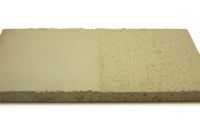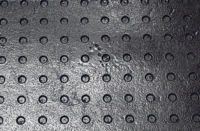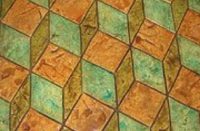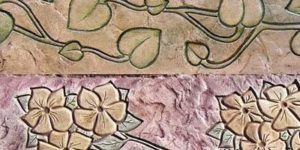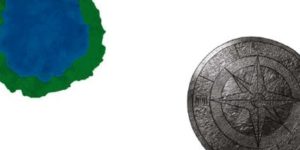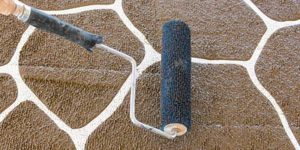I was on the verge of giving up on decorative concrete after offering stamped concrete for three years as part of my company’s concrete services. What changed my mind? The creation of texture stamping, thanks to the invention of what today we call texture stamp mats. If not for this stamping revelation, I would have missed out on a great opportunity and you surely wouldn’t be reading this article.
Before texture stamping, stamping professionals were limited to interlocking stamp patterns and all of the frustration and anxiety that accompany them. Flash forward to 2014, and numerous opportunities exist to showcase your decorative talent, thanks to the many variations of texture stamp tools.
The benefit of randomness
The customer’s “expectation thermometer” rises the minute a contractor sells an upgrade such as stamped concrete. This means that the customer will no longer view a slab of concrete as merely functional. That concrete must now also be decorative and complementary to all other surrounding improvements. Mastering the stamping process in order to meet these expectations requires a combination of effort and knowledge. This is the learning curve. Luckily, a great benefit of texture stamping is that the skills to create an attractive hardscape can be learned quickly.
The concrete placement, coloring and finishing process remains the same, regardless of the stamping process or pattern, up to the point of imprinting. But as soon as the actual stamping process begins, the simplicity of texture stamping prevails. Texture stamp tools require no special alignment or interlocking. Nor do they require a stamping professional to stop and analyze how one tool (or mat) pattern fits into the previous one. Texture mats have the benefit of randomness, which means a crew can stamp one area and then jump to another area on the project’s opposite side, even if that means leaving a gap between. This luxury is seldom shared by interlocking stamp patterns.
Timing is crucial
Poor timing is the greatest threat to concrete placement. Since most exterior decorative concrete is placed in warm weather months, the window for stamping the surface is limited. Meeting a customer’s expectations hinges on the consistency of color and surface impressions. Color consistency can be improved later on during the sealing stage, but the same is not true with impressions. It is imperative to consistently imprint the concrete surface the day of the pour.
Texture stamping requires half the time and effort compared to other interlocking stamp patterns. I recently timed two crew members as they texture-stamped a 500-square-foot patio in less than half an hour. Their expediency lead to a consistently stamped patio that our customer found attractive and I found profitable.
The ability to imprint concrete faster means the same effort and manpower will imprint more surface area in less time. As you know, labor is the hardest item to estimate, and that’s why the efficient nature of texture stamping is an added benefit to the bottom line.
Works well with joints and edges
Texture stamping has other attractive advantages over interlocking patterns that simulate stone, brick or tile. Like all concrete surfaces, stamped concrete requires tooling or saw cutting to allow the concrete to crack in a controlled fashion. Ignoring this crucial step will eventually lead to an unattractive display of random cracking that most customers will not find appealing. The aforementioned interlocking patterns do not look natural with tooled or saw cut lines running through their pattern, but this is not true with texture stamping. Tooled or saw cut “breaks” add to the appeal of texture stamping, especially when they are preplanned and coordinated.
Another attractive benefit of texture stamping is how it seamlessly blends with free-flowing edges around a project’s perimeter. This is not so true with interlocking patterns. Free-formed lines (curvilinear) appeal to the eye more than square corners or straight lines often observed with interlocking stamp patterns. This is one reason why texture stamp patterns are most common around pool decking and connecting sidewalks. Texture stamping’s ability to simulate lines seen in nature is appealing to the eye. This helps create an organic hardscape that only texture patterns can provide.
The option to easily master a skill that creates an attractive, yet profitable, decorative concrete service is always worth pursuing. Nearly all stamp tool manufacturers now offer texture stamp mats in various sizes and shapes. Unlike with most interlocking patterns, it is not necessary to purchase more than three or four stamp tools in most cases.
